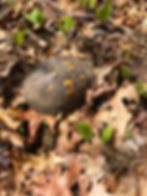CRITTER SPOTLIGHT: Eastern Box Turtle (Terrapene carolina carolina)
- cynthiamorissette
- May 17, 2020
- 2 min read
Good Morning Watershed Explorers,
I hope you enjoyed the last two beautiful days. We are being rewarded with another bright, sunny day today as well. I hope that you will get out and explore. Today's critter spotlight is all thanks to my wonderful mother-in-law who sent us this great picture of an eastern box turtle, Terrapene carolina carolina. She found this beauty while on a walk in South Kingstown, RI.

The eastern box turtle is one of six subspecies of the common box turtle. There are two distinct ways to identify this turtle, the orange-yellow markings on its shell, and the four toes on its hind feet. The box turtle received its name because it can pull its head and legs directly into its shell and close up like a box to avoid predators. Its shell can even regenerate!
Turtles are known for having pretty long lifespans, but the common eastern box turtle has an average one of 25-35 years. Some individuals have been known to live to almost 100, but that isn't common.
Habitat:
The eastern box turtle lives on land in areas with a lot of vegetation. This might include grasslands, marshy meadows, forest edges, and woodlands. They are often found in areas that surround bodies of water.
Diet:
Adult eastern box turtles are omnivores and will eat a variety of plants and animals. They are also called opportunistic, which means that they will eat whatever is available in their environment. This might include, mushrooms, grass, fruit, insects, eggs, amphibians, and sometimes even animals that have died. The young are more active in water and tend to be more carnivorous because they grow very quickly and need energy.
Watershed Role:
Eastern box turtles turn over the land when they dig in leaves and dirt to create new homes. This helps to uncover fertile soil so that new plants and seeds can grow. Like all species, eastern box turtles are an important part of the food chain. The main concern for turtles is habitat loss, often times eastern box turtles are killed when people develop on their land. Eastern box turtles are listed as vulnerable on the International Union for Conservation of Nature and Natural Resources' Red List.
I hope that you enjoyed learning a little bit about the eastern box turtle. I gathered a lot of the information for today's blog from the Smithsonian's National Zoo and Conservation Biology Institute, check out this page for even more information https://nationalzoo.si.edu/animals/eastern-box-turtle
I hope you all have a wonderful day!
Much love,
Mrs. Morissette


